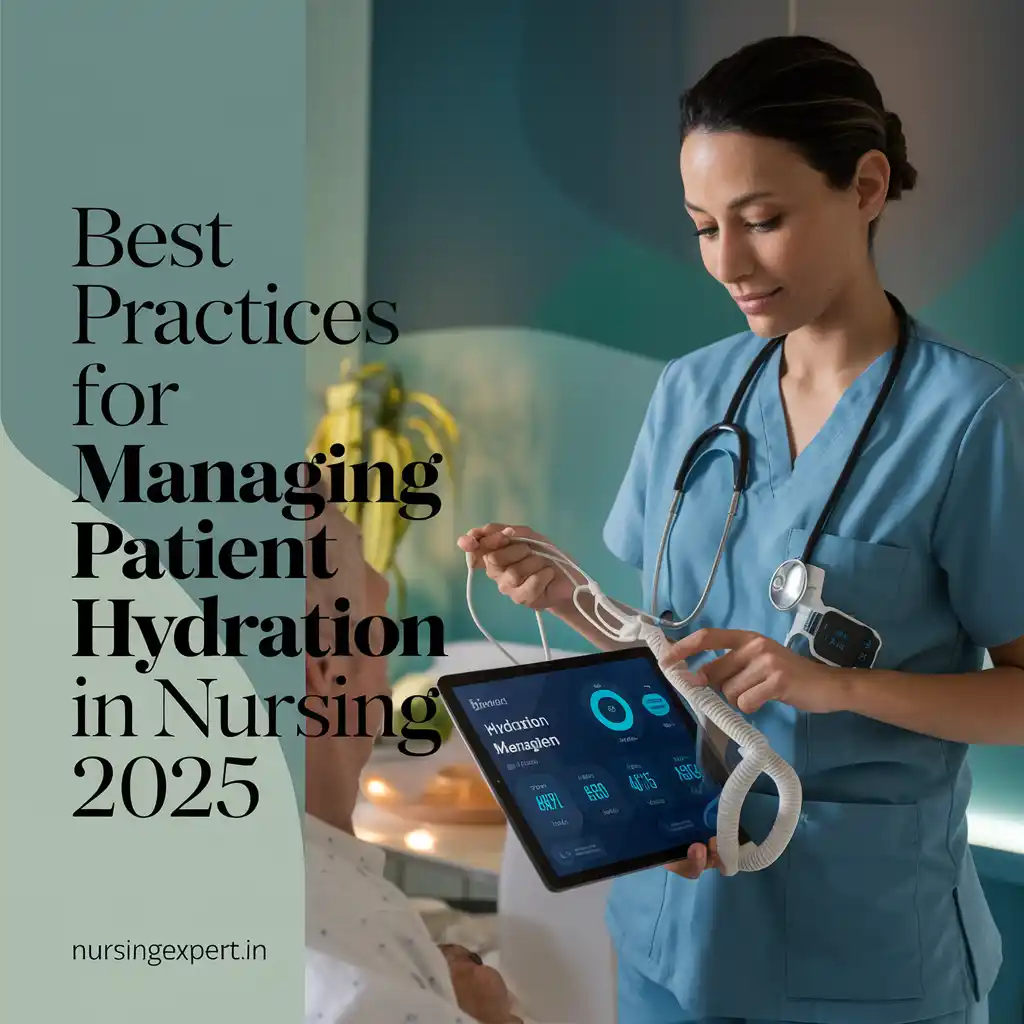Proper hydration is essential for every patient’s recovery and overall well-being. In 2025, nurses are at the forefront of ensuring that hydration management is integrated into patient care, using both traditional care methods and emerging digital tools. Patient hydration management involves more than simply encouraging water intake—it requires a comprehensive approach that addresses the patient’s clinical status, personalized needs, and barriers to maintaining adequate hydration. This article explores best practices for patient hydration management, outlining assessment strategies, interventions, the role of technology, interdisciplinary collaboration, and future trends in nursing care.
Thank you for reading this post, don't forget to subscribe!
Introduction
Hydration is a critical component of health that affects every physiological system. Inadequate hydration can lead to complications such as electrolyte imbalances, kidney dysfunction, decreased cognitive function, and delayed wound healing. For patients in various healthcare settings—from acute hospitals to long-term care facilities—maintaining proper hydration is vital for recovery and overall health.


In 2025, the rise of digital health tools, coupled with ongoing research and patient-centered care models, has brought new approaches to hydration management. Nurses play a key role in assessing hydration status, educating patients about the importance of fluids, and implementing personalized care plans. This article provides an in-depth exploration of best practices for managing patient hydration, offering practical strategies to help nurses improve care, reduce complications, and enhance patient outcomes.
Understanding Patient Hydration
a. The Importance of Hydration in Health
Hydration is essential because it:
- Supports Physiological Functions: Water is needed for digestion, circulation, temperature regulation, and cellular metabolism.
- Prevents Complications: Adequate hydration helps prevent issues such as urinary tract infections, kidney stones, constipation, and pressure ulcers.
- Enhances Recovery: Hydration is key to tissue repair, wound healing, and overall recovery from illness or surgery.
- Improves Cognitive Function: Maintaining proper hydration contributes to better mental alertness and reduces fatigue.
b. Recognizing Signs of Dehydration
Nurses must be vigilant in identifying signs of dehydration in patients. Common indicators include:
- Physical Signs: Dry mucous membranes, reduced skin turgor, sunken eyes, tachycardia (rapid heart rate), low blood pressure, and dark urine.
- Behavioral and Cognitive Changes: Confusion, lethargy, dizziness, and irritability.
- Laboratory Findings: Elevated blood urea nitrogen (BUN) and creatinine levels, hypernatremia (high sodium), and concentrated urine.
Accurate assessment of hydration status is critical for developing effective interventions and preventing complications.
The Role of Nurses in Hydration Management
Nurses have a unique and vital role in hydration management, as they are often the primary caregivers responsible for monitoring and encouraging fluid intake. Their responsibilities include:
a. Comprehensive Assessment
i. Conducting Regular Evaluations
- Patient History: Gather information about dietary habits, previous episodes of dehydration, chronic conditions (e.g., kidney disease, heart failure), and medication side effects (such as diuretics that increase fluid loss).
- Physical Examination: Check for clinical signs of dehydration, such as dry skin, mucous membranes, and abnormal vital signs.
- Diagnostic Testing: Use laboratory tests like blood and urine analyses to assess hydration status.
ii. Using Standardized Tools
- Hydration Assessment Scales: Implement tools that quantitatively assess hydration levels, similar to pain scales, to provide objective data.
- Digital Monitoring: Utilize digital devices and wearable sensors that can continuously monitor patient vitals linked to hydration status (such as heart rate, blood pressure, and urine output).
b. Developing Individualized Hydration Care Plans
i. Creating Personalized Goals
- Tailor Goals to Patient Needs: Set short-term and long-term hydration goals based on individual patient conditions, age, and comorbidities.
- Collaborative Planning: Involve patients and their families in setting achievable targets for fluid intake.
ii. Interventions and Modalities
- Oral Fluid Management: Encourage and assist patients with drinking fluids by scheduling regular fluid intake and offering preferred beverages.
- Alternative Routes: For patients unable to consume adequate fluids orally, coordinate with physicians to implement intravenous (IV) hydration or enteral feeding as required.
- Complementary Therapies: Support hydration with nutritional counseling and, when necessary, the use of electrolyte-balanced drinks.
c. Patient and Family Education
i. Educating Patients on the Importance of Hydration
- Clear Explanations: Use simple language and visual aids to explain why hydration is important for recovery and overall health.
- Teach Self-Monitoring: Educate patients on how to recognize early signs of dehydration and the importance of regular fluid intake.
- Empower Family Caregivers: Provide family members with strategies to help monitor and encourage hydration, ensuring they understand how to support the patient at home.
ii. Digital Resources for Education
- Mobile Apps: Recommend apps that track fluid intake, provide reminders, and offer educational tips about hydration.
- Online Platforms: Use patient portals and telehealth sessions to deliver interactive educational content on maintaining proper hydration.
d. Utilizing Technology in Hydration Management
i. Digital Monitoring and Analytics
- Wearable Devices: Implement wearable technology that continuously monitors vital signs associated with hydration, such as heart rate and blood pressure.
- Data Integration: Ensure that hydration data is integrated into electronic health records (EHRs) to facilitate real-time review by the care team.
- AI and Analytics: Use predictive analytics to identify patients at higher risk of dehydration, enabling proactive intervention.
ii. Telehealth Consultations
- Remote Monitoring: Leverage telehealth to conduct regular virtual check-ins, particularly for homebound or remote patients.
- Online Education and Support: Provide virtual resources and support groups for patient education on hydration.
e. Fostering Interdisciplinary Collaboration
i. Collaborative Care Teams
- Work with Dietitians: Engage dietitians to develop nutritional strategies that promote hydration.
- Coordinate with Physicians: Ensure that hydration goals are integrated into overall treatment plans by working closely with physicians, especially for patients with complex medical conditions.
- Involve Pharmacists: Collaborate with pharmacists to review medication regimens that may contribute to dehydration and adjust treatments as needed.
ii. Community Partnerships
- Outreach Programs: Partner with community organizations to provide resources that improve access to healthy beverages and hydration education for vulnerable populations.
- Support Networks: Develop networks that connect patients with local support services, such as water quality initiatives and nutritional programs.
Challenges in Hydration Management
Despite best practices, several challenges persist in effectively managing patient hydration:
a. Time Constraints and Workload
- High Patient Loads: Busy clinical environments may limit the time available for thorough hydration assessments and patient education.
- Documentation Requirements: Balancing patient care with detailed documentation can reduce the time for direct patient interactions.
b. Patient Barriers
- Limited Access to Fluids: Some patients may have physical or economic barriers that limit access to adequate fluids.
- Cognitive Impairments: Patients with dementia or other cognitive impairments might struggle with self-monitoring fluid intake.
- Cultural Preferences: Cultural beliefs and practices around food and beverages may influence hydration behaviors.
c. Technological Limitations
- Digital Literacy: Variations in digital literacy among patients, especially older adults, can hinder effective use of digital monitoring tools.
- Integration Issues: Difficulties in integrating new technological tools with existing healthcare systems may compromise data accuracy and usability.
d. Systemic and Organizational Barriers
- Resource Allocation: Limited resources and staffing shortages can impede the implementation of comprehensive hydration programs.
- Policy Gaps: Inadequate institutional policies may fail to prioritize hydration management, leading to inconsistent practices.
Future Trends in Patient Hydration Management
a. Advancements in Wearable Technology
- Improved Sensors: Future wearables will offer more accurate and continuous monitoring of hydration-related vital signs, such as skin conductivity, body temperature, and fluid balance.
- Personalized Alerts: Devices will increasingly provide personalized alerts and recommendations to both patients and healthcare providers, allowing for proactive management.
b. Integration of Artificial Intelligence (AI)
- Predictive Analytics: AI-driven systems will analyze real-time data to predict dehydration risks, triggering early interventions.
- Customized Care: AI will help personalize hydration plans based on a patient’s unique health profile and response to treatment.
c. Expansion of Telehealth and Digital Platforms
- Virtual Monitoring: Telehealth platforms will facilitate regular virtual assessments, especially for patients in remote or underserved areas.
- Interactive Education: Enhanced digital tools will offer interactive educational resources to teach patients about the importance of hydration and methods to maintain it.
d. Interdisciplinary and Community-Based Care Models
- Collaborative Networks: Increased interdisciplinary collaboration will integrate hydration management into overall care plans, ensuring a more holistic approach.
- Community Partnerships: Enhanced partnerships with community organizations will improve access to hydration resources and public health education on fluid intake.
Frequently Asked Questions (FAQs)
Q1: Why is patient hydration management important?
A: Proper hydration is crucial for maintaining physiological functions, supporting recovery, preventing complications (such as kidney problems and infections), and improving overall patient outcomes. Inadequate hydration can lead to a host of health issues and compromise the effectiveness of treatment.
Q2: How do nurses assess a patient’s hydration status?
A: Nurses assess hydration status through comprehensive evaluations that include patient history, physical examination (e.g., skin turgor, mucous membranes), vital signs, and laboratory tests. Digital tools and wearables are also increasingly used to monitor hydration in real time.
Q3: What are some key interventions for managing hydration?
A: Interventions include creating personalized fluid intake plans, utilizing nutritional counseling, implementing digital monitoring tools, providing education on the importance of hydration, and addressing any physical, economic, or cultural barriers that may impede adequate fluid intake.
Q4: How can technology enhance hydration management in nursing?
A: Technology such as wearable devices, mobile apps, and telehealth platforms facilitates continuous monitoring of hydration markers, supports remote patient education, and enables proactive interventions when signs of dehydration are detected.
Q5: What role does interdisciplinary collaboration play in hydration management?
A: Collaboration among nurses, dietitians, physicians, and other healthcare professionals helps ensure that hydration care is comprehensive. It allows for the integration of diverse expertise to create effective, patient-centered hydration strategies.
Q6: What challenges do nurses face in managing patient hydration?
A: Common challenges include time constraints, patient barriers (such as cognitive impairments or limited access to fluids), technological hurdles, and systemic issues like staffing shortages. Addressing these challenges requires a coordinated, resourceful approach.
Q7: What future trends are expected in patient hydration management?
A: Future trends include the expansion of wearable technology, the integration of AI for predictive analytics, enhanced digital education platforms for patients, and stronger interdisciplinary and community-based collaboration to address the holistic needs of patients.
Conclusion
Effective hydration management is essential for promoting recovery, preventing complications, and ensuring overall patient health. In 2025, nurses are enhancing their role through comprehensive assessments, personalized care plans, and the integration of advanced digital tools. By prioritizing patient education, leveraging interdisciplinary collaboration, and embracing innovative technology, nurses are better equipped to meet the complex hydration needs of their patients.
The future holds promising advancements, from AI-powered predictive tools to more sophisticated wearables and telehealth platforms, all designed to empower nurses and improve patient outcomes. As healthcare continues to evolve, a commitment to proactive, patient-centered hydration management will remain a cornerstone of quality nursing care—one that not only supports physical health but also enhances the overall well-being of every patient.
Investing in ongoing education, fostering a collaborative work environment, and advocating for effective policies are key to ensuring that patients receive the hydration care they need for optimal health and recovery. With compassion and innovation, nurses can pave the way for a healthier future where hydration management becomes an integral part of holistic patient care.
References and Sources
- American Nurses Association (ANA). (2023). Patient Hydration and Nutrition Management. Retrieved from https://www.nursingworld.org
- Centers for Disease Control and Prevention (CDC). (2024). Hydration and Health Guidelines. Retrieved from https://www.cdc.gov/nutrition
- Journal of Clinical Nursing. (2023). Innovations in Hydration Management. Retrieved from https://journals.lww.com/jcn
- Institute for Healthcare Improvement (IHI). (2022). Quality Improvement in Patient Care: Hydration Strategies. Retrieved from https://www.ihi.org
- Peer-reviewed articles from the International Journal of Nursing Studies and Health Affairs.
- Additional resources from the World Health Organization (WHO) and recent policy briefs on digital health and patient nutrition.


